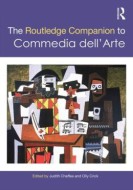Book Review: The Routledge Companion to Commedia dell’Arte
The Routledge Companion to Commedia dell’arte
Judith Chaffee and Olly Crick, editors
London and NY: Routledge, 2014
ISBN: 9780415745062
540 pp.
Commedia dell’arte was born in Italy almost certainly as a result of influences from the ancient Roman comic theatre, borrowing archetypal characters from its traditions while emphasizing improvisation as its style. Commedia actors and their characters are now the stuff of theatrical legend as a result of their mastery of improv and the fundamental human situations and interactions their improvised plays depicted. Alas, we cannot see them perform, though for centuries artists have provided iconic images, capturing the seemingly unattainable idea of the actor as artist improvising plays to create an indelible comic form. Commedia’s historical influence is incalculable, but is seen most vividly in the scripted plays of Shakespeare, Molière, Lope de Vega, Carlo Goldoni, and Carlo Gozzi; and also appears in Punch and Judy, pantomimes, harlequinades, and in many operas and ballets. Commedia also influenced the works of diverse twentieth century artists: Gordon Craig, Vsevolod Meyerhold, Jacques Copeau, Max Reinhardt, Luigi Pirandello, Dario Fo, and the Theatre of the Absurd playwrights, among a multitude of others.
In our time, the phrase commedia dell’arte is applied with impunity to any performer or performance making use of improv, stock characters, masks, and/or anarchic farce. As such, the phrase sometimes appears almost meaningless in contemporary theatre. However, The Routledge Companion to Commedia dell’arte brings together diverse contributions (many quite short) of variant quality from over fifty scholars, translators, mask makers, actors, and other practitioners, proving that this inspiring form continues to permeate contemporary theatre culture. In three sections and a thorough bibliography the contributors to this collection explore: the singular performance aspects of pure commedia in “The Defining Features: Actors Scenarios, Troops, Stock Characters, Masks, Language and Lazzi;” the rich cultural history of the form in “Historical Context;” and the present-day manifestations of commedia’s inspiration in “Alive and Well and Living In….” Fully-packed with rich factual information from the featured scholars and idiosyncratic viewpoints from the practitioners, the volume provides a rich, if incomplete compendium.
The editors have made a valiant effort to provide a comprehensive accounting of commedia then and now, but with a subject that reigned in its purest form for more than three-hundred years, with wildly diverse tentacles of influence in multiple cultures, this admirable attempt is ultimately futile. Inevitably, significant figures, plays, and influences are overlooked or under-reported. Despite this, the book has enormous value as a resource and guide, providing much well-researched historical material and commentary of practitioners who find commedia a fertile stimulus. At this point a more complete portrait of commedia through the ages would be difficult to find.
The hefty publisher’s price ($205.00, mirroring the book’s literal heftiness) may prevent individuals from adding this useful, well-illustrated book to their private collections (unless it finds its way into paperback), so it is likely that only libraries with strong performing arts collections will acquire it. This volume serves as a worthy addition to the vast scholarship on a most unique theatrical form, and is likely to remain a potent inspiration to performing artists and scholars alike.
James Fisher
The University of North Carolina at Greensboro

